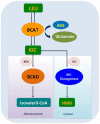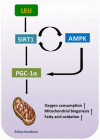Leucine Supplementation: A Novel Strategy for Modulating Lipid Metabolism and Energy Homeostasis
- PMID: 32370170
- PMCID: PMC7282259
- DOI: 10.3390/nu12051299
Leucine Supplementation: A Novel Strategy for Modulating Lipid Metabolism and Energy Homeostasis
Abstract
Lipid metabolism is an important and complex biochemical process involved in the storage of energy and maintenance of normal biological functions. Leucine, a branched amino acid, has anti-obesity effects on glucose tolerance, lipid metabolism, and insulin sensitivity. Leucine also modulates mitochondrial dysfunction, representing a new strategy to target aging, neurodegenerative disease, obesity, diabetes, and cardiovascular disease. Although various studies have been carried out, much uncertainty still exists and further studies are required to fully elucidate the relationship between leucine and lipid metabolism. This review offers an up-to-date report on leucine, as key roles in both lipid metabolism and energy homeostasis in vivo and in vitro by acceleration of fatty acid oxidation, lipolysis, activation of the adenosine 5'-monophosphate-activated protein kinase (AMPK)-silent information regulator of transcription 1 (SIRT1)-proliferator-activated receptor γ coactivator-1α (PGC-1α) pathway, synthesis, and/or secretion of adipokines and stability of the gut microbiota.
Keywords: adipokine; energy axis; leucine; lipid metabolism; microbiota.
Conflict of interest statement
The authors declare no conflict of interest.
Figures



Similar articles
-
The diabetes medication canagliflozin promotes mitochondrial remodelling of adipocyte via the AMPK-Sirt1-Pgc-1α signalling pathway.Adipocyte. 2020 Dec;9(1):484-494. doi: 10.1080/21623945.2020.1807850. Adipocyte. 2020. PMID: 32835596 Free PMC article.
-
Leucine supplementation increases SIRT1 expression and prevents mitochondrial dysfunction and metabolic disorders in high-fat diet-induced obese mice.Am J Physiol Endocrinol Metab. 2012 Nov 15;303(10):E1234-44. doi: 10.1152/ajpendo.00198.2012. Epub 2012 Sep 11. Am J Physiol Endocrinol Metab. 2012. PMID: 22967499 Free PMC article.
-
Activation of the AMPK/Sirt1 pathway by a leucine-metformin combination increases insulin sensitivity in skeletal muscle, and stimulates glucose and lipid metabolism and increases life span in Caenorhabditis elegans.Metabolism. 2016 Nov;65(11):1679-1691. doi: 10.1016/j.metabol.2016.06.011. Epub 2016 Jul 9. Metabolism. 2016. PMID: 27456392
-
PGC-1α as a Pivotal Factor in Lipid and Metabolic Regulation.Int J Mol Sci. 2018 Nov 2;19(11):3447. doi: 10.3390/ijms19113447. Int J Mol Sci. 2018. PMID: 30400212 Free PMC article. Review.
-
PGC-1alpha-mediated regulation of gene expression and metabolism: implications for nutrition and exercise prescriptions.Appl Physiol Nutr Metab. 2008 Oct;33(5):843-62. doi: 10.1139/H08-074. Appl Physiol Nutr Metab. 2008. PMID: 18923559 Review.
Cited by
-
The association between dietary branched-chain amino acids and the risk of cardiovascular diseases in Chinese patients with type 2 diabetes: A hospital-based case-control study.Front Nutr. 2022 Oct 14;9:999189. doi: 10.3389/fnut.2022.999189. eCollection 2022. Front Nutr. 2022. PMID: 36313094 Free PMC article.
-
The impact of acute beta-hydroxy-beta-methylbutyrate (HMB) ingestion on glucose and insulin kinetics in young and older men.J Funct Foods. 2020 Oct;73:104163. doi: 10.1016/j.jff.2020.104163. J Funct Foods. 2020. PMID: 33101462 Free PMC article.
-
Genetically Predicted Leucine Level Mediates Association Between CD4/CD8br T Lymphocytes and Insomnia.Cell Mol Neurobiol. 2025 Jan 22;45(1):15. doi: 10.1007/s10571-025-01533-5. Cell Mol Neurobiol. 2025. PMID: 39841266 Free PMC article.
-
Neuregulin1 ameliorates metabolic dysfunction-associated fatty liver disease via the ERK/SIRT1 signaling pathways.BMC Gastroenterol. 2025 Jan 30;25(1):47. doi: 10.1186/s12876-025-03632-5. BMC Gastroenterol. 2025. PMID: 39885382 Free PMC article.
-
Leucine-Rich Diet Improved Muscle Function in Cachectic Walker 256 Tumour-Bearing Wistar Rats.Cells. 2021 Nov 23;10(12):3272. doi: 10.3390/cells10123272. Cells. 2021. PMID: 34943780 Free PMC article.
References
-
- Block R.J. Some Amino Acids, Peptides and Amines in Milk, Concentrated Milks and Cheese. J. Dairy Sci. 1951;34:1–10. doi: 10.3168/jds.S0022-0302(51)91662-1. - DOI
-
- Gruhn K. Effect of the set of amino acids contained in casein, extracted soy bean meal, horse beans and wheat gluten on the content of leucine, isoleucine, valine, phenylalanine, tyrosine, glutamic acid, aspartic acid, alanine, glycine and proline in the deproteinized blood plasma of laying hens. Arch Tierernahr. 1973;23:609–622. doi: 10.1080/17450397309425599. - DOI - PubMed
-
- Salles J., Chanet A., Berry A., Giraudet C., Patrac V., Domingues-Faria C., Rocher C., Guillet C., Denis P., Pouyet C., et al. Fast digestive, leucine-rich, soluble milk proteins improve muscle protein anabolism, and mitochondrial function in undernourished old rats. Mol. Nutr. Food Res. 2017;61:1700287. doi: 10.1002/mnfr.201700287. - DOI - PubMed
-
- Kamruzzaman M., Torita A., Sako Y., Al-Mamun M., Sano H. Effects of feeding garlic stem and leaf silage on rates of plasma leucine turnover, whole body protein synthesis and degradation in sheep. Small Rumin. Res. 2011;99:37–43. doi: 10.1016/j.smallrumres.2011.03.052. - DOI
Publication types
MeSH terms
Substances
Grants and funding
- 2018YFD0500405/National Basic Research Program of China (973 Program)
- 31972582/National Natural Science Foundation of China
- kq1801059/Science and technology projects of changsha
- KFJ-STS-QYZD-052/STS regional key projects of Chinese Academy of Science
- 2017QNCXTD_ZCS/Youth Innovation Team Project of ISA, CAS
LinkOut - more resources
Full Text Sources
Medical

